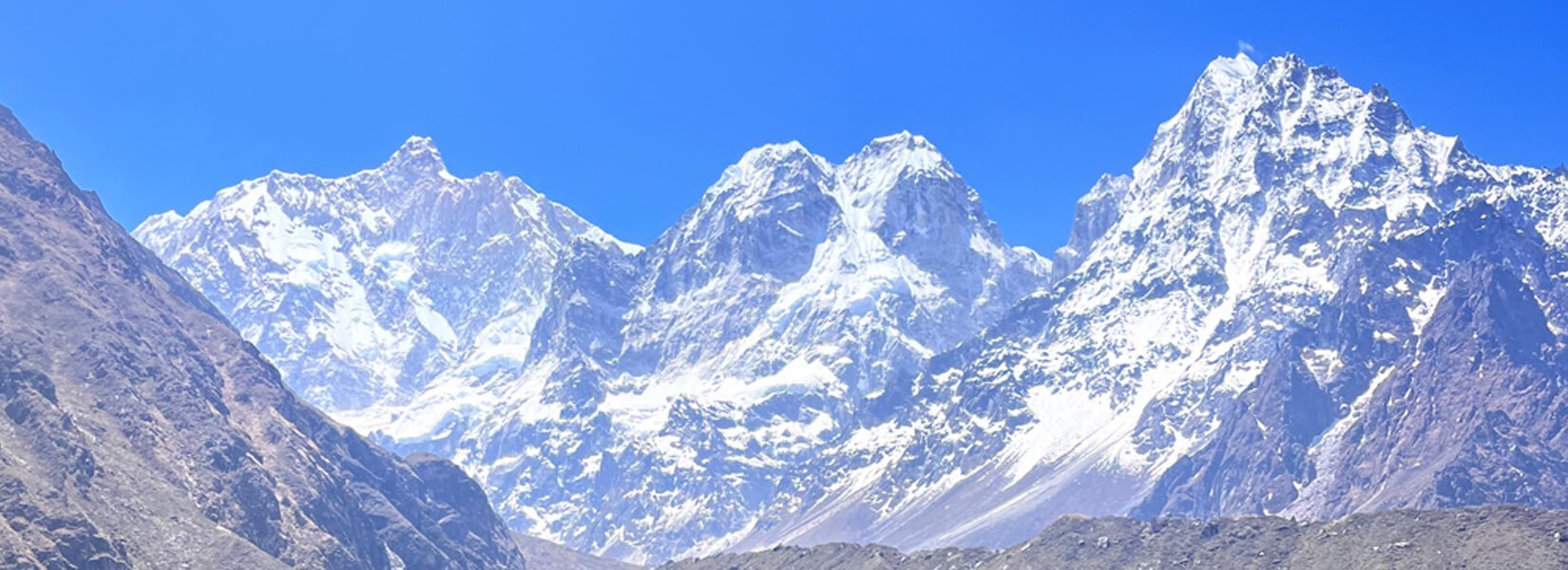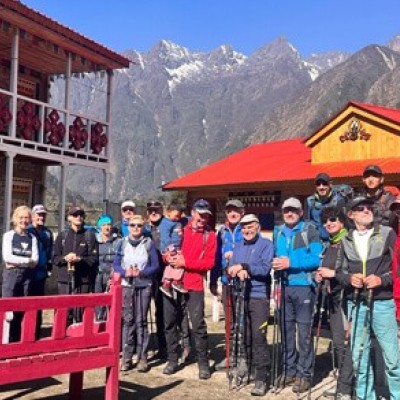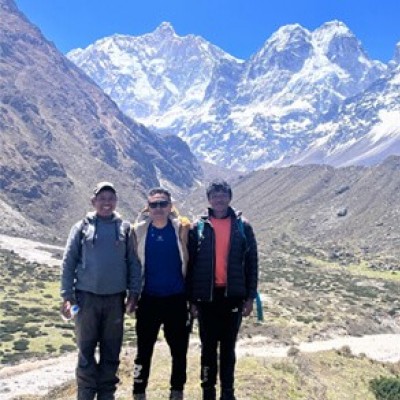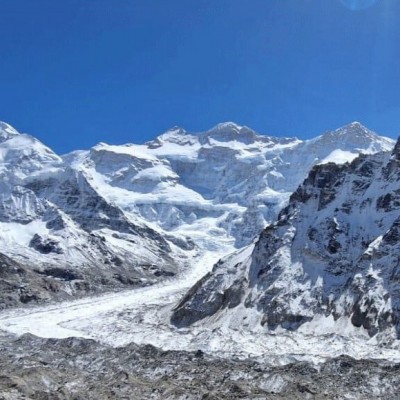What attracts risk-takers to the Kanchenjunga Trekking route?
Amidst several restricted and secluded trekking routes in Nepal, the Kanchenjunga trekking is in demand among risk-takers, as the region offers to test physical endurance in high-elevation terrain with close views of Kanchenjunga (8586 m) and neighboring peaks. After the government allowed hikers to trek to the region in 1988, more of Mount Kanchenjunga's facts and other attractions gained recognition.
Kanchenjunga South and North Base Camps
The key highlights of the Kanchenjunga trek are Pangpema/North (5143 m) and Oktang/South (4730 m) base camps that provide stunning panoramic scenes and a profound sense of achievement since you need to traverse steep, narrow, and more rugged terrain, including landslide-prone areas, icy, snowy trails, and glacial moraine.
High Mountain Passes of the Kanchenjunga
Adventurers love this route for both challenges and rewards, depending on the well-tailored itinerary, with gradual ascents and descents with the help of a Nepal trekking guide, even if it’s a brief version of the journey or the Kanchenjunga Circuit Trek. One of the most anticipated moments of the trek is crossing high mountain passes such as Sele La (4480 m), Sinion La (4646 m), and Mirgin La (4645 m), which are also perfect vantage points of the route for sunrises and sunsets over the Himalayan ranges.
Remote but stunningly high settlements
The most isolated settlements, such as Amjilosha, Gyabla, Khambachen, Ghunsa, Ramche, Chairam, etc., present you with authentic Himalayan cultures and traditions of Sherpa, Rai, and Limbu, influenced by Tibetan Buddhism. Besides the picturesque treasures of the region, hikers can learn more about the daily life and the authentic cultures of the Limbu, Rai, and Sherpa, influenced by Tibetan Buddhism.
Historical and religious Sites
Seize a remarkable opportunity to discover heritage Buddhist monasteries lined with flapping prayer flags and prayer wheels, together with small chortens and mani walls. To sum up, Kanchenjunga Treks are more than typical trekking experiences in high-altitude mountainous landscapes. Therefore, hikers prefer Kanchenjunga treks for the pros and cons in the wilderness of far-eastern Nepal, near the border between Nepal and India.
Diverse wildlife and Vegetation
Kanchenjunga treks take you through the Kanchenjunga Conservation Area, offering glimpses of unique wildlife and vegetation to capture on camera in their natural habitat. As the conservation is a home to diverse birds, it is also a perfect trip for bird watchers. A professional Nepal trekking guide can suggest you the best spot for the best views of rare animals and birds as well as other different creatures, and plants.
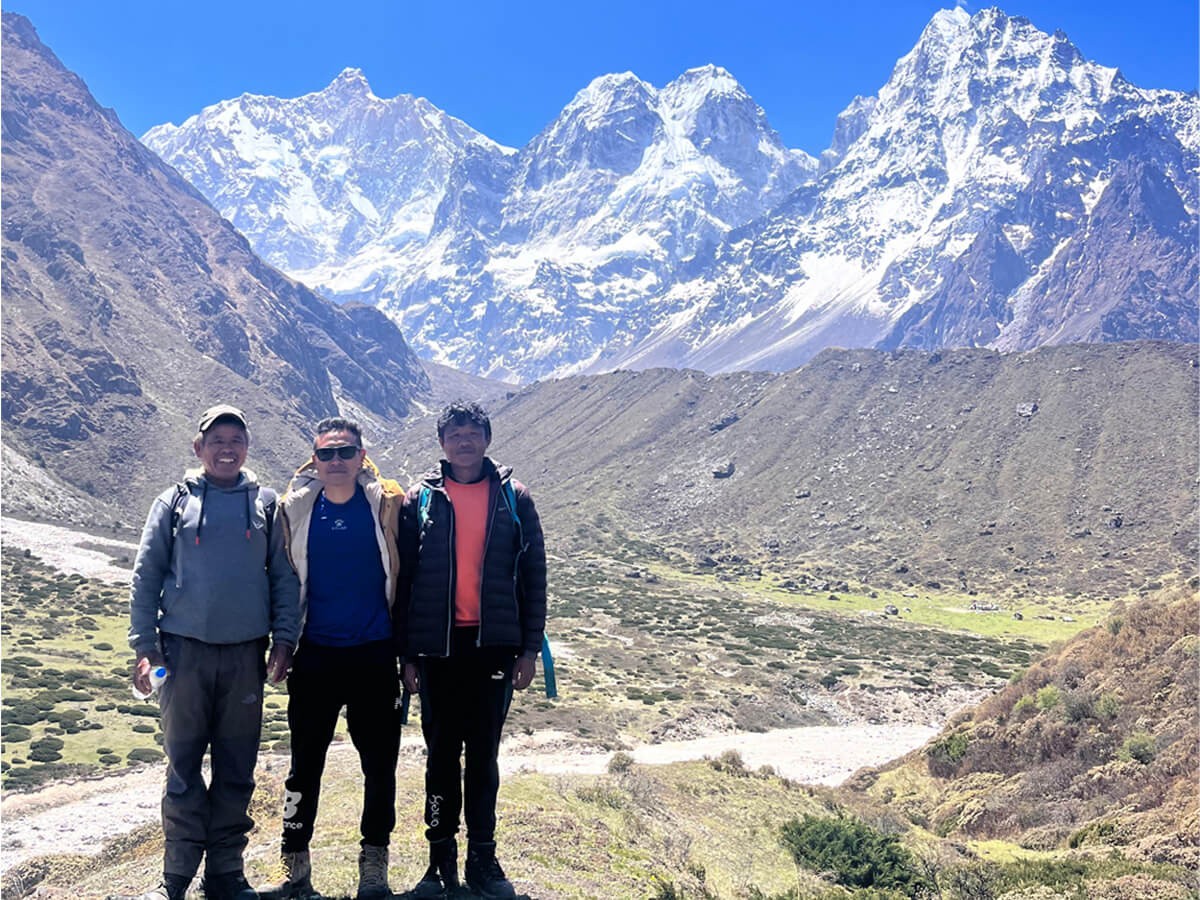
Why hire a guide for the Kanchenjunga Trek?
Any treks, including Kanchenjunga Trekking, without a guide in Nepal are not possible anymore due to safety and systematic as well as sustainable tourism approaches, whether you are a professional or a novice trekker. Moreover, the government has listed the Kanchenjunga as a restricted area due to its proximity to a neighboring country and to preserve the fragile ecosystems and untouched culture. As the remote areas present notable risks and numerous incidents lead to loss of life, a seasoned guide is crucial for handling any circumstances on the trails that may occur because of heavy rains, snowfall, and storms.
The guide is not only for navigating strenuous portions of the Kanchenjunga treks, as a professional guide manages all logistics for the journey and, also being fluent in English and local languages of the region, assists you to learn the facts, explaining the history of the places and cultural heritage. In this way, make a deep connection with locals and get involved in various cultural activities. Therefore, hire an expert guide with many years of experience in the field of Nepal tourism to enhance your hiking and guarantee security.
The highest-level risk of the Self-guided Kanchenjunga Trek is the chance of losing the trail and delaying rescue in the event of an injury, as you may not have contact with the nearest administration. Dialect problems will not let you understand locals’ instructions during emergencies and may lead to misunderstanding or misjudgment. Even if the government permits it, the difficulty level of the Kanchenjunga Solo Trek renders it unfeasible.
How is our Kanchenjunga Trekking map helpful for a guide and trekkers throughout the journey?
Use a Kanchenjunga Trekking map and a compass for this off-the-beaten-path trek, which lets you trek stress-free. Nepal Adventure Team has designed the map, including clearly every trek’s major trails, side trip destinations, villages, and vantage points, making it easier for all hikers regardless of fitness levels. As this trekking equipment is your reliable companion, you can continue the trek with outstanding exactness.
However, only a seasoned Nepal trekking guide can choose the accurate alternative route when unforeseen obstacles block the planned trails, as shown on the created maps. Therefore, although you have prior experience in the Himalayas with a map and a compass, the Self-guided Kanchenjunga Trek is not possible because of unknown local paths. Ensure that the chosen package provides details about elevation and landscapes, alerting you to the isolated and demanding areas.
To reach destinations on time, avoiding an unstable Trekking map strengthens you to walk for a prolonged time with a peaceful mind and enough self-assurance via diverse, awe-inspiring topographies. For trekkers' safety, the Nepalese government brought in a rule that it is not possible to trek without a guide in Nepal. For example, you can see the Classic Kanchenjunga Circuit Trek map as follows:
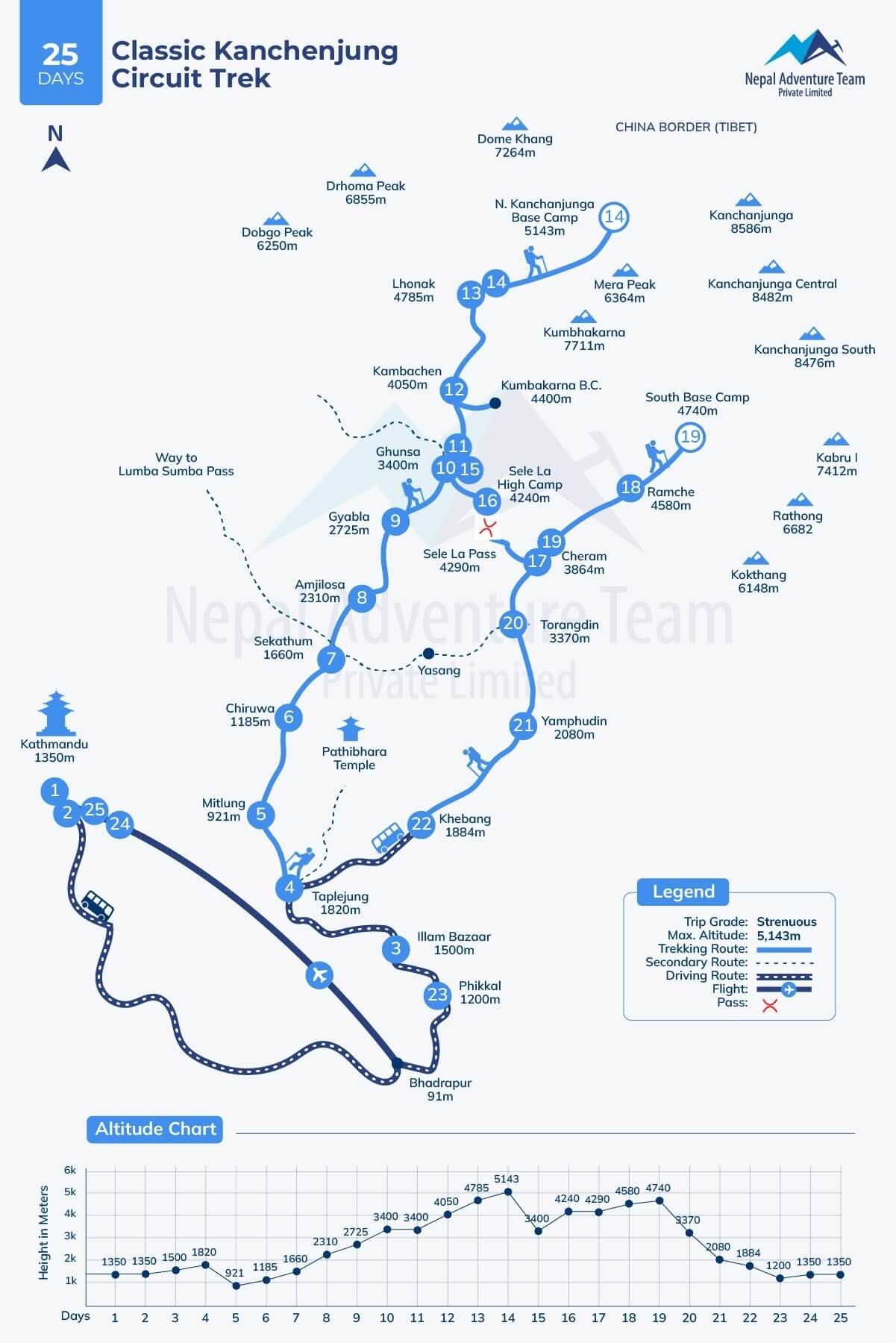
How to hire a registered trekking guide for the Kanchenjunga Region Trekking?
Strategic preparation includes appointing a professional guide who guarantees your safety, a perfect adventurous trip, and cultural immersion without letting you feel worried about logistics or navigation. The Kanchenjunga trekking is strenuous due to its remoteness and few established paths compared to more commercialized trekking routes such as Annapurna Base Camp or Everest Base Camp. Therefore, it is crucial to hire a licensed trekking guide who can handle all things throughout the trek. You should consider the following things while choosing the right one:
Select an authorized trekking agency.
Due to an irresponsible local trekking agency, trekkers have to face several challenges on the way. Therefore, ensure that you have planned for the trip through a travel company registered with the government that follows the rules and regulations of the government. Such an agency with a good knowledge of the region can secure your safety, trustworthy logistics, and firsthand cultural experiences, reducing potential risks.
Examine Guide Certifications and Skills
Checking whether your guide has a valid license and sufficient experience in the Kanchenjunga region or not is crucial before confirming the guide for such challenging trekking. Therefore, check if your guide has original official documents authorized by the Nepal Tourism authorities, because it is a matter of your safety. What happens when your guide can not handle bad situations and trekking logistics during the Kanchenjunga trek? Therefore, do not compromise while hiring a guide.
When you are in doubt about the guide’s expertise, you can search reviews on the company’s website. Confirm that your guide can understand locals’ languages and help you to make a bond with them. You must know that your guide can navigate every path and play a vital role in remote areas to give trekkers the best experience, allowing them to hike without stressing about logistics, including permits, accommodation, food, etc.
You can have a conversation on a video chat to check their communication skills. And before venturing on the journey, meet your guide for further inquiries that help you on the trails.
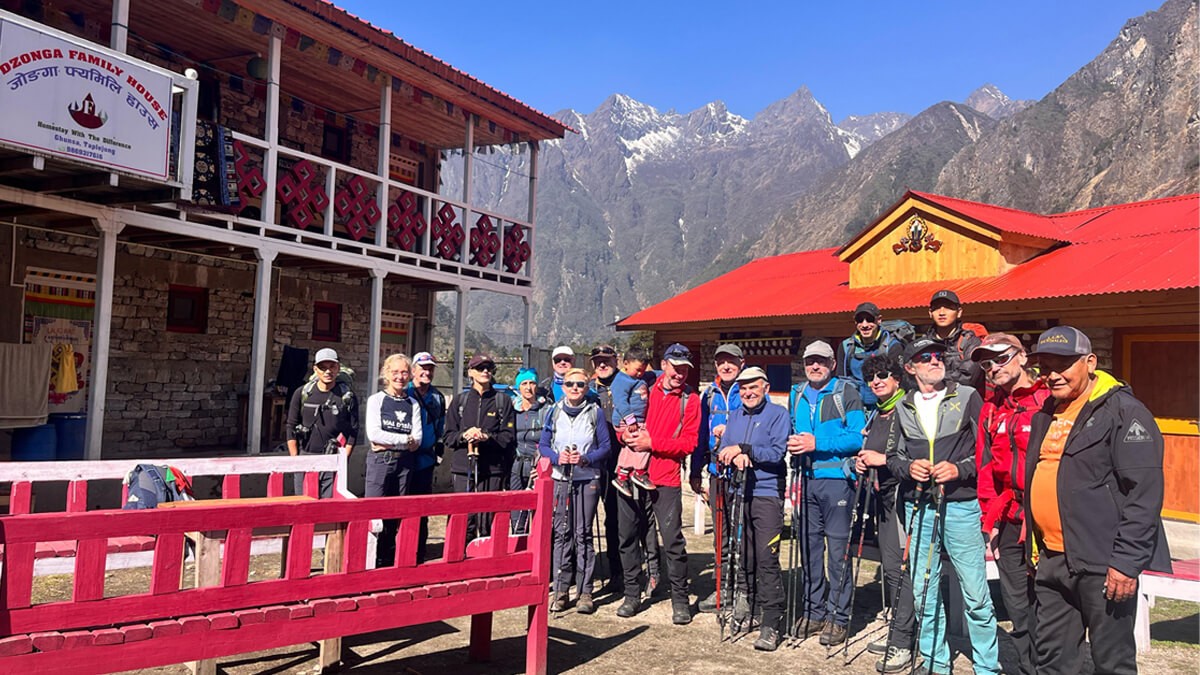
Is a porter mandatory for the Kanchenjunga Trekking, similar to a guide? (for example, Kanchenjunga Circuit Trek Map)
Depending on the Government regulations for solo trekking in Kanchenjunga, a guide is compulsory for trekking in Nepal. Although hiring a porter is not mandatory, we highly suggest that you be accompanied by both a professional guide and a porter, as the Kanchenjunga Trekking is one of the longest routes in Nepal with steep and rough terrain, requiring trekkers’ high level of fitness. Traversing such demanding trails with heavy loads is challenging, not letting you relish the charm of the region.
Therefore, choose a reputable trekking agency in Nepal that can provide a reliable porter who carries your loads, adding more comfort to your journey. Hike from verdant woodlands to more rugged terrain without worrying about loads, savoring the surreal beauty of nature, and soothing your eyes with the awe-inspiring vistas of the scenery and towering snow-clad peaks. You are not only hiring a guide to make your journey smooth, but also supporting the local economy.
Solo vs. Group Trekking Experience in Kanchenjunga
Kanchenjunga Solo Trek can provide a risk bearer a broad space to explore, making a deep connection with nature, far from the chaos of crowded cities with modern technologies. While choosing solo trekking in Kanchenjunga, you can walk at your own pace and manage logistics depending on your preferences. However, a self-guided trek in such secluded locations may be risky. Even though you have a Kanchenjunga trekking map and a direction compass, you could miss the right path. In emergencies or event of an injury, you may not be able to contact the nearest local administration due to a lack of good internet and not having their contact numbers.
However, solo trekkers also can not do the Kanchenjunga Trekking without a guide in Nepal anymore, requiring a guide at any cost. While talking about Solo vs. Group Trekking experience in Kanchenjunga, you can safely trek in a group. Hikers can share each other’s experiences and help a needy person. Helping trekkers one another physically and mentally, group hiking can be the best. The cost for permits, food, transportation, a guide, and a porter, etc. split, reducing expenses individually. If you attempt for self-guided trek to the Kanchenjunga region, you may encounter problems due to the Nepal Trekking Rules for Solo Trekking in Kanchenjunga.
What are other essential things to know for Kanchenjunga Treks?
Although Solo trekking in Kanchenjunga is not possible these days, as it requires a guide, you need to concentrate on several things to complete your odyssey.
When are the Best Seasons For Kanchenjunga Treks?
Trekking in Nepal, including the Kanchenjunga Trek with a qualified guide, also requires choosing the ideal period to minimize difficulties on the trails. Autumn (September to November) and spring (March to April) offer you the opportunity to hike on firm paths due to the stable weather and moderate temperatures of these months. Mountain enthusiasts can enjoy unobstructed vistas of snow-covered peaks, as the chance of rainfall is minimal.
During these trekking seasons, the environment not only allows people to enjoy its favorable climate but also nurtures various wildlife and dense greenery. While traversing lush forests filled with rhododendrons, oaks, pines, and birches of the Kanchenjunga Conservation Area, witness rare animals like musk deer, Himalayan black bears, snow leopards, blue sheep, Himalayan tahr, etc. Monsoon brings rain to almost everywhere in Nepal, creating problems including landslides, floods, and increasing leeches on the trail.
Winter’s severe cold also heightens the Kanchenjunga Trek difficulty, as trekkers can not continue walking on snowy or icy trails under freezing temperatures in high-altitude terrain. The steep ascents and descents at the time of crossing the high mountain passes require a stable footpath to ensure a smooth and visually rewarding adventure through the most isolated areas and breathtaking terrains of Kanchenjunga.
What permits do you need to trek to the Kanchenjunga region?
Since the Kanchenjunga trekking takes you to one of the restricted areas in Nepal, it necessitates three permits, including a TIMS (Trekkers Information Management System), a KCAP (Kanchenjunga Conservation Area Permit), and a KRAP (Kanchenjunga Restricted Area Permit). These paper documents are essential to track trekkers during the entire journey to ensure safety and control tourism for the preservation of the fragile ecosystems and unique Himalayan flora.
To obtain these permits easily, select the reputable trekking agencies that handle everything through the Nepal Tourism Board (NTB) offices and the Department of Wildlife Conservation. Carry a copy of your passport, required fees, and other documents, and fill out the form with the support of the chosen company. Do not break the rules and regulations while hiking through a wide-ranging topography, since the penalties can be strict and may lead to penalties, expulsion from the territory or even legal consequences.
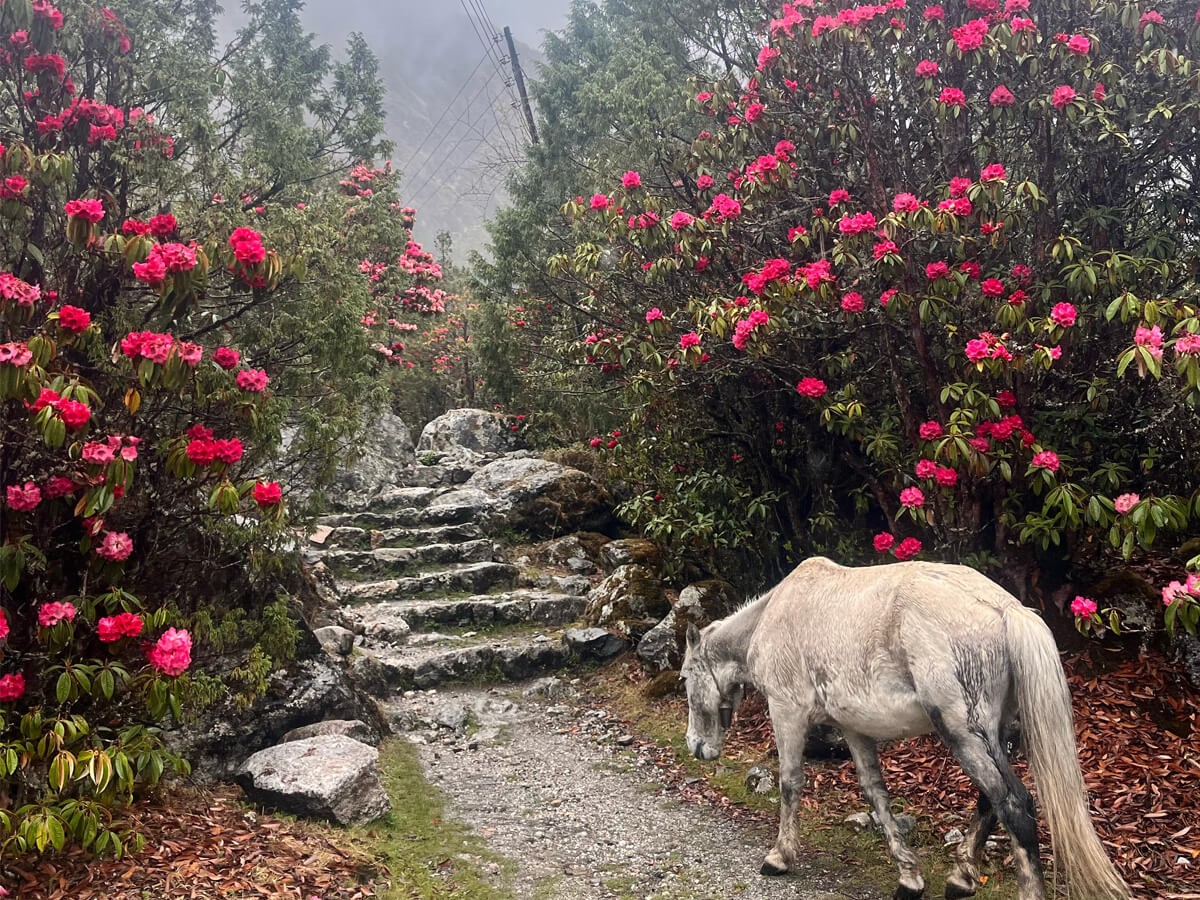
Why do you need Travel Insurance for Kanchenjunga Treks?
A seasoned Nepal trekking guide significantly reduces the possibility of an unfortunate event for hikers due to the strictness of Nepal Government regulations for solo trekking in Kanchenjunga. However, Travel insurance is a crucial aspect of the Kanchenjunga trek, as it helps you to protect yourself from unplanned expenditures. Travel insurance covers the costs if unexpected events occur, such as flight delays or cancellations, or the loss, damage, or theft of personal belongings. Moreover, the insurance covers the cost of medical treatment in case of injury while navigating uneven terrain.
Transportation access is difficult, and health posts are limited in remote hamlets of the Kanchenjunga, often leading to delayed rescue in times of emergencies. Therefore, ensure that the chosen travel insurance covers helicopter evacuation above 3000 m, offering the services whether the symptoms of acute mountain sickness occur or you may sustain an injury. In general, travel insurance works as a safeguard, guaranteeing your pleasant trip with peace of mind and budgetary safety. Whether you love Self-guided Kanchenjunga treks or group hiking, we advise you to obtain travel insurance through a reliable company.
What Food and Accommodation are available on the Kanchenjunga Trekking trails?
Unlike Solo trekking in Kanchenjunga, a professional guide manages logistics, including reliable lodges and food, which are core requirements. Although the Kanchenjunga region has isolated terrain, trekkers can find common teahouses that are yet comfortable and safe for overnight stays. Do not expect modern facilities in the high mountainous landscapes, as you have to adjust to simple rooms with basic amenities, with a shared bed, little furniture, blankets, and shared bathrooms. With increasing elevations, the accommodations are limited and less facilitated, requiring an extra sleeping bag or light blanket to keep yourself warm.
Generally, the restaurants, teahouses, and hotels along the Kanchenjunga trail provide Nepalese “Dal and Bhat” that consists of steamed rice, lentil soup, seasonal green vegetables, and pickle, which play a vital role in keeping you more energetic for walking long days in the Himalayas. At lower elevations, more facilitated teahouses provide more cozy rooms with modern furniture, private washrooms, hot showers, and Wi-fi, together with a wide range of foods, including Tibetan (thukpa, momos, tsampa) and Western food (pasta, omelets, fried rice, pancakes, toast, etc.).
Food is fresh and delicious, although the varieties are limited in high-elevation settlements. Because of transportation difficulties, few shops are available along the Kanchenjunga trekking trails. Therefore, carry some nutritious snacks like dried fruits, nuts, chocolates, energy bars, raisins, dates, biscuits, potatoes, etc. Respecting locals' hard work for serving you, respect every individual, and do not attempt to bargain on costs since the region is less established and the costs are quite higher than the actual cost since they transport things with the help of mules or porters.
How do you reach the initial point of the Kanchenjunga trekking?
After landing in Kathmandu, enjoy Kathmandu guided sightseeing and prepare for long days of walking. You can either travel to Bhadrapur by airplane or pubic deluxe bus, or private jeep, enjoying the stunning scenery. From there, a road ride takes you to the initial point of hiking Sekathum, or Taplejung, based on your chosen packages. After completing the journey, you again have an option to get back to Kathmandu by flight or four-wheel drive. If you choose group trekking, the transportation fee is also reduced than in self-guided Kanchenjunga Trek.
Conclusion
To sum up, choose any trekking package that you want in the Kanchenjunga region, whether you are alone or with a group, we can manage hiking depending on your desires, attempting to provide you with the best experience, better than Kanchenjunga Solo Trekking. We provide a proficient trekking guide and a local porter who can support you along the way, managing every essential thing on the journey. Plan your next trip with Nepal Adventure Team for satisfying services. For further inquiries, contact us on WhatsApp or email.
